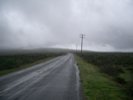First, the basics for those who might be interested in the story but not so interested that they’d entertain the notion of getting on a bicycle themselves for three or four days and pedaling from long before dawn to well after dark: The Colorado Last Chance Randonée is a 1,200-kilometer ride from the Boulder, Colorado, area to north-central Kansas and back; the event has a 90-hour limit, meaning you have to finish the 750 miles in six hours less than four days to have your result recognized by the people who recognize such things. What that boils down to is the necessity to ride 200 miles a day, on average, day after day after day after day. And you do it because? Because it’s a challenge to get it done and I’m not doing other challenging things like — well, you can fill in the blank.
As I explained earlier, I was riding the event in a two-part formal: a 1,000-kilometer (623-mile) portion that would allow me to qualify for a long-distance cycling award, and a finishing 200-kilometer portion. For whatever reason, my left Achilles tendon became very painful about 40 miles from the end of the 1,000; I managed to finish that, but didn’t do the final 200. I finished riding Friday, September 15; I went to the Last Chance dinner in greater Boulder on Saturday, the 16th; I flew home to Berkeley on Sunday, the 17th; on Saturday, the 23rd, I took my bike out of its case and put it back together and went for a ride, wanting to see how the Achilles is doing. Still hurts. It might be a while before I do another long ride. We’ll see.
Anyway, here (follow the link) is the rest of the Last Chance story, all however-many episodes.
Technorati Tags: colorado, cycling, kansas, pbp, randonneuring, travel
Technorati Tags: colorado, cycling, kansas, pbp, randonneuring, travel



